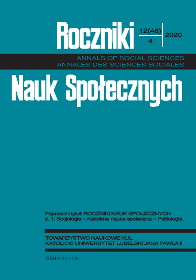Stakes and Conflict as Mechanisms of Creating Narrative Suspense in James Bond Movies. Research Report
Abstract
The stakes play an important role in intensifying the conflict between the protagonist and the antagonist, and thus, the emotional reaction of the target audience. The James Bond film series often follow a plot pattern of „preventing atrocity”, in which the main character is supposed to stop the villain from implementing a morally evil plan. Stakes modification is done through various techniques: by masking the actual stakes, by increasing the negative consequences of a failure, by increasing the positive consequences of winning and by reducing the possibility of achieving the goal. Moreover, these films are characterized by the global nature of the conflict, which is emphasized on two levels. At the level of the threat scale, where public goals (political, economic, social, humanitarian consequences) are more important than private goals (emotional, moral consequences). And at the level of the form of the threat, where the stakes of the conflict are embedded in fantastic fear. The absurdity and caricatural nature of threats is realized by presenting them in the context of a conflict of values (e.g. good versus evil).
References
Bell J.S., Plot and structure: Techniques and exercises for crafting a plot that grips readers from start to finish, Cincinnati: Writer’s Digest Books 2004.
Black J., The world of James Bond: The lives and times of 007, Lanham: Rowman and Littlefield 2017.
Brake M., The Science of James Bond: The Super-Villains, Tech, and Spy-Craft Behind the Film and Fiction, New York: Skyhorse Publishing 2020.
Carroll N., Toward a theory of film suspense, „Persistence of vision” 1984, nr 1, s. 65-89.
Comisky P., Bryant J., Factors involved in generating suspense, „Human Communication Research” 1982, nr 1, s. 49-58.
Dodds K., Screening Geopolitics: James Bond and the Early Cold War films (1962-1967), „Geopolitics” 2005, nr 2, s. 266-289.
Funnell L., Dobbs K., Geographies, Genders and Geopolitics of James Bond, London: Palgrave Macmillan 2016.
Gerrig R., The Resiliency of Suspense, w: Suspense: Conceptualizations, Theoretical Analyses, and Empirical Explorations, red. P. Vorderer, H. Wulff, M. Friedrichsen, London: Routledge 1996, s. 93-105.
Hardy J., Understanding conflict, United States: Fiction University Press 2017.
Hendrykowski M., Słownik terminów filmowych, Poznań: Ars Nova 1994.
Jose P., Brewer W., Development of Story Liking: Character Identification, Suspense, and Outcome Resolution, „Developmental Psychology” 1984, nr 5, s. 911-924.
Madrigal R., Bee C., Chen J., LaBarge M., The Effect of Suspense on Enjoyment Following a Desirable Outcome: The Mediating Role of Relief, „Media Psychology” 2011, nr 3, s. 259-288.
Morrell J., Between the lines: master the subtle elements of fiction writing, Cincinnati: Writer’s Digest Books 2006.
Newton M., Writing Thrillers: The Writerʼs Guide to Crafting Tales of Suspense, Cincinnati: Writer’s Digest Books 2013.
Obstfeld R., Fiction First Aid, Cincinnati: Writer’s Digest Books 2001.
Ortony A., Clore G., Collins A., The Cognitive Structure of Emotions, Cambridge: Cambridge University Press 1990.
Smith J., „How Safe Do You Feel?”: James Bond, Skyfall, and the Politics of the Secret Agent in an Age of Ubiquitous Threat, „College Literature” 2016, nr 1, s. 145-172.
Smuts A., The Desire-Frustration Theory of Suspense, „The Journal of Aesthetics and Art Criticism” 2008, nr 3, s. 281-290.
Truffaut F., Hitchcock/Truffaut, tłum. T. Lubelski, Izabelin: Świat Literacki 2005.
Wied de M., The role of temporal expectancies in the production of film suspense, „Poetics” 1995, nr 1, s. 107-123.
Zillmann D., Mechanisms of emotional involvement with drama, „Poetics” 1994, nr 23, s. 33-51.
Zillmann D., Hay T.A., Bryant J., The effect on suspense and its resolution on the appreciation of dramatic presentations, „Journal of Research Personality” 1975, nr 9, s. 307-323.
Zillmann D., The psychology of suspense in dramatic exposition, w: Suspense: Conceptualizations, Theoretical Analyses, and Empirical Explorations, red. P. Vorderer, H. Wulff, M. Friedrichsen, London: Routledge 1996, s. 199-232.
Copyright (c) 2020 Roczniki Nauk Społecznych

This work is licensed under a Creative Commons Attribution-NonCommercial-NoDerivatives 4.0 International License.


